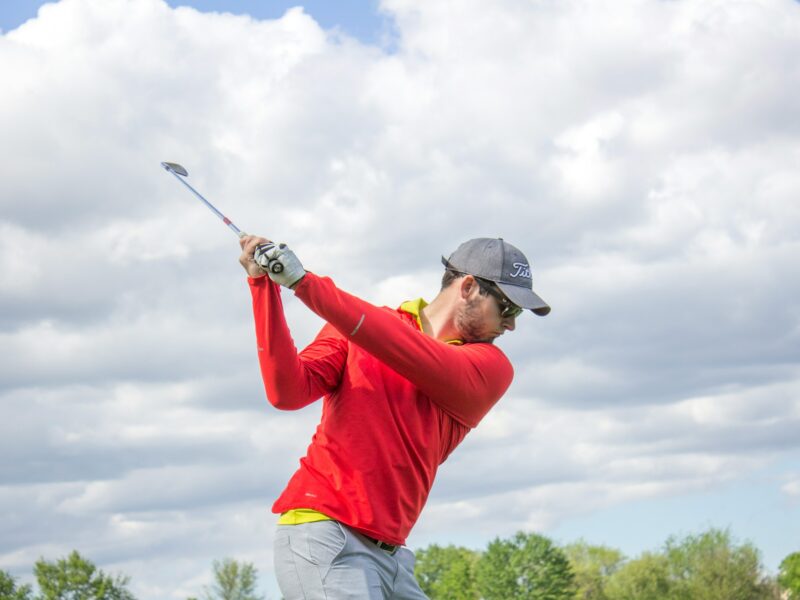Golf, while generally considered a low-impact sport, can still result in various injuries such as back pain, golfer’s elbow, wrist tendinitis, rotator cuff injuries, and knee pain.
These injuries are often due to repetitive motions and improper techniques.
Utilizing the right equipment, such as supportive footwear, properly fitted clubs, and protective braces, can significantly reduce the risk of injury.
Advanced tools like golf launch monitors can also help by providing detailed feedback on swing mechanics, allowing golfers to make necessary adjustments to improve their form and prevent injuries.
Preventing Back Pain in Golf
Back pain is a common issue among golfers due to the repetitive and rotational nature of the golf swing.
This pain can range from mild discomfort to severe, debilitating conditions, significantly affecting a golfer’s performance and enjoyment of the game.
Fortunately, several strategies and pieces of equipment are designed to prevent and manage back pain, ensuring a healthier and more enjoyable golfing experience.
Using Launch Monitors to Improve Swing Mechanics

Launch monitors are invaluable tools for golfers looking to refine their swing mechanics and prevent injuries, particularly back pain.
These devices provide detailed data on various aspects of the golf swing, such as club speed, ball speed, launch angle, and more.
By analyzing this data, golfers can identify and correct improper techniques that may contribute to back strain.
Using a launch monitor allows golfers to see real-time feedback and make necessary adjustments to their stance, swing path, and impact position.
This helps in developing a more efficient and less physically taxing swing.
When they optimize their swing mechanics, golfers can reduce the excessive rotational forces on the spine, minimizing the risk of back injuries.
Importance of Proper Footwear
Wearing the right shoes is pivotal in preventing back pain. Golf shoes should provide adequate support, stability, and cushioning to absorb the impact of walking and swinging.

Proper footwear helps ma
intain good posture and alignment throughout the game, reducing the strain on the lower back.
Shoes with good arch support and shock-absorbing soles can help distribute the body’s weight evenly, preventing excessive pressure on the spine.
Golfers should also consider using custom orthotics if they have specific foot issues or need additional support.
Orthotics can improve foot alignment and reduce stress on the knees and lower back, providing a more comfortable and pain-free golfing experience.
Benefits of Using a Golf Bag with Wheels
Carrying a heavy golf bag can significantly strain the back muscles, leading to pain and potential injuries.
To alleviate this, golfers can use golf bags with wheels or electric caddies. These bags eliminate the need to carry heavy loads, reducing the physical stress on the back.
Golf bags with wheels are designed to be ergonomic, ensuring that the weight is evenly distributed and easy to maneuver around the course.

Electric caddies further reduce the effort required to move the bag, allowing golfers to focus on their game without worrying about back pain.
Preventing Golfer’s Elbow: Life Saving Equipment
Golfer’s elbow, or medial epicondylitis, is a common condition that causes pain and inflammation in the tendons connecting the forearm to the elbow.
This injury is often the result of repetitive stress and improper technique.
Fortunately, there are several pieces of equipment that can help prevent this painful condition, allowing golfers to enjoy the game without discomfort.
Using Elbow Braces

One of the most effective pieces of equipment for preventing a golfer’s elbow is an elbow brace or counterforce brace.
These braces provide support and reduce strain on the tendons, helping to distribute the stress exerted during a golf swing more evenly across the arm.
When wearing a brace, golfers can significantly lower the risk of tendon overuse and injury. It’s paramount to select a brace that fits well and provides adequate compression without restricting movement.
Upgrading Golf Clubs

Using the right golf clubs can make a significant difference in preventing golfer’s elbow.
Clubs that are too heavy or have grips that are too small can increase the strain on the forearm muscles and tendons.
Switching to lighter graphite clubs and ensuring the grips are appropriately sized can help reduce this strain.
Proper club fitting is indispensable, especially for beginners who may not yet have developed proper form.
Consulting with a professional for club fitting can ensure that the clubs match the golfer’s body mechanics and swing style, minimizing the risk of injury.
Using Shock-Absorbing Gloves
Another useful piece of equipment is shock-absorbing golf gloves. These gloves are designed to reduce the impact and vibration transmitted to the hands and arms when striking the ball.
By absorbing some of the shock, these gloves can help prevent the tiny tears in the tendons that lead to golfer’s elbow.
They can improve grip and control, which contributes to better swing mechanics and reduces the likelihood of injury.

Preventing Wrist Injuries in Golf
Wrist injuries are common among golfers due to the repetitive nature of the swing and the significant forces involved.
These injuries can range from mild strains to more serious conditions such as tendinitis and fractures.
However, using the right equipment can help prevent these injuries and allow golfers to play pain-free.
Wrist Braces
Wearing a wrist brace can provide support and stability to the wrist during swings, reducing the risk of injuries.

Wrist braces help to maintain proper wrist alignment and limit excessive movements that can lead to strain.
They are particularly useful for golfers who have a history of wrist injuries or who experience discomfort during play.
When choosing a wrist brace, look for one that is adjustable and made from breathable materials to ensure comfort during long rounds of golf.
Properly Fitted Golf Clubs
Using golf clubs that are properly fitted to your body and swing style can significantly reduce the risk of wrist injuries.
Clubs that are too heavy or too long can increase the strain on your wrists, leading to tendonitis and other issues.
Professional club fitting can ensure that the clubs you use are the right length, weight, and have the appropriate grip size for your hands.
This customization helps in maintaining proper swing mechanics and reduces the risk of improper wrist movements that can cause injury.
Shock-Absorbing Grips
Grips that absorb shock can play a vital role in preventing wrist injuries and much like shock absorbing gloves they are supposed to protect you from an injury .

These grips are designed to minimize the vibration and impact that travels up the club and into the wrists when striking the ball.
By reducing these forces, shock-absorbing grips help protect the tendons and ligaments in the wrist from overuse injuries.
They are particularly beneficial for golfers who frequently practice on hard surfaces like mats, which can exacerbate wrist strain.
Endnote
Maintaining a proactive approach to injury prevention in golf involves not only using the appropriate equipment but also engaging in regular conditioning and strength training and being well rested.
Implementing proper warm-up routines and staying informed about body mechanics can further reduce the risk of injury.
By investing in the right gear and taking care of your physical health, you can enjoy a long, injury-free golfing experience.
Want to unlock greater wellness?
Listen to our friends over at the Wellness + Wisdom Podcast to unlock your best self with Drew Canole of Organifi:









 Back to Balance: The Evolution of Chiropractic Care and Health Advancements
Back to Balance: The Evolution of Chiropractic Care and Health Advancements